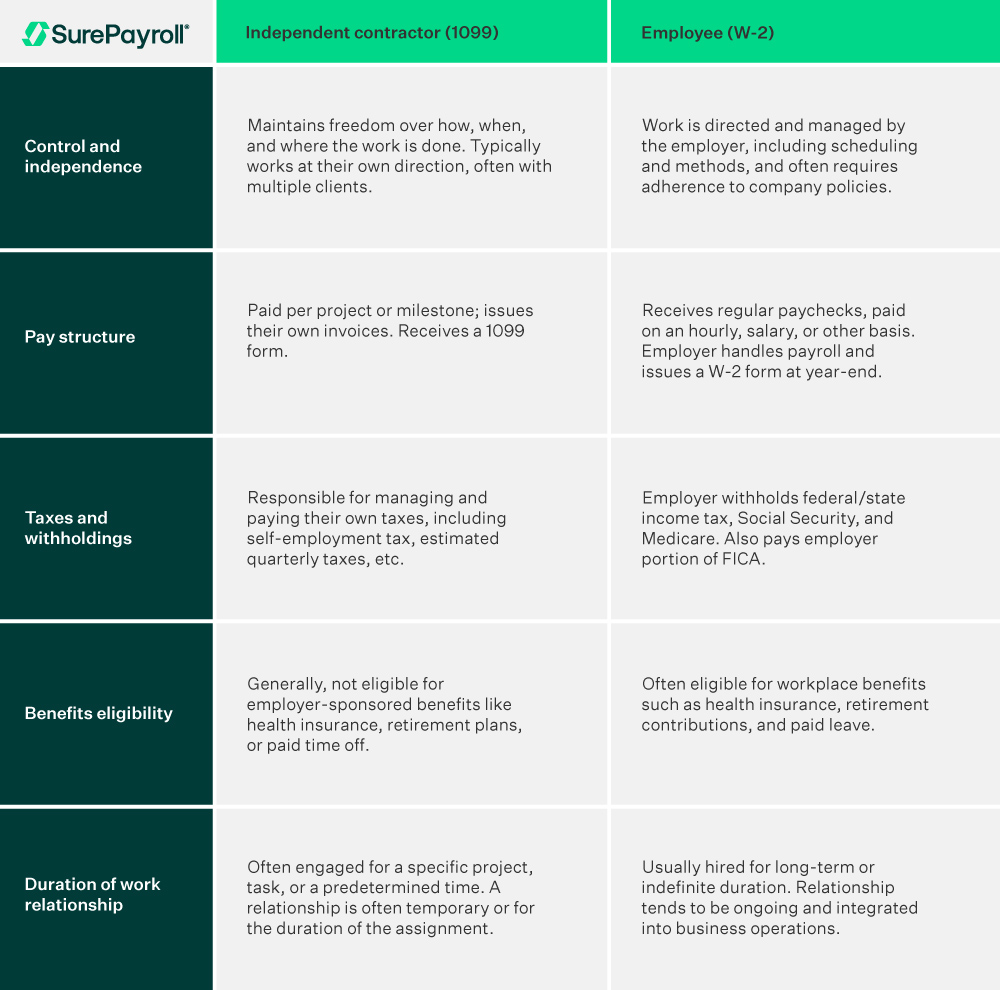Learn the key differences between independent contractors and employees.
When you bring someone new into your business, one of your first responsibilities is deciding what kind of help you need. That will help you determine how to classify them: employee or independent contractor. The distinction may sound technical, but it has far-reaching implications for how you pay that worker, the tax forms you issue, and the protections they may receive.
Misclassification can carry serious consequences. Workers who are incorrectly classified as contractors may miss out on important protections, including overtime pay and access to benefits.
Employers, meanwhile, risk costly fines, penalties, back pay, and lawsuits if they fail to get it right.
What Is an Independent Contractor?
Many small businesses engage independent contractors, sometimes referred to as 1099 workers or non-payroll workers, to take on specific tasks or projects. These arrangements are often temporary and can be a cost-effective way to access specialized skills without committing to a long-term hire.
Independent contractors can include professionals such as freelancers, consultants, and gig workers. They set their own schedules, provide their own tools, and may work with several clients at the same time.
What Is an Employee?
An employee is someone hired directly by a business to perform ongoing work under the company’s direction and control. Employees are part of the company’s payroll system, typically receive a regular paycheck, and are issued a W-2 form at tax time.
Employees often fill long-term roles that are central to the business, and they generally work on a set schedule using tools, equipment, or resources provided by their employer. Examples can include administrative staff, customer service representatives, and in-house professionals such as accountants or marketing specialists.
Because employees are on payroll, business owners must withhold federal and state taxes, Social Security, and Medicare, while also paying the employer’s share of FICA taxes. Many companies also provide additional benefits, such as health insurance, retirement plans, and paid time off, which are not typically offered to contractors.
One of the key considerations when evaluating contract worker vs employee classification is the control the employer has over the work, both in terms of what tasks are performed and how they are carried out.
Independent Contractor vs Employee: Key Differences
Below is a quick comparison of the differences between employee and independent contractor classifications across some key areas, from control and pay to legal rights and benefits.
CHART

Learn more about the key differences between Form 1099 vs W-2.
IRS & DOL Tests for Worker Classification
The IRS uses what’s known as the common law test to help determine whether a worker should be classified as an employee or an independent contractor. These factors revolve around the level of control a business has in the working relationship:
- Behavioral control: Does the company direct how the work is done, or does the contractor make those decisions independently?
- Financial control: Who decides how the worker is paid, whether expenses are reimbursed, and who provides the necessary tools or supplies?
- Type of relationship: Is there a written contract? Are benefits such as insurance or retirement included? Is the work ongoing and central to the business?
No single factor is conclusive. Employers must evaluate the entire relationship before determining how to classify a worker.
The U.S. Department of Labor (DOL) provides its own standards for determining worker status under the FLSA. The DOL’s focus is on whether the worker is economically dependent on the business (more like an employee) or operating independently in the marketplace (more like a contractor). Factors such as the permanence of the relationship, the worker’s opportunity for profit or loss, and the degree of control exercised by the business all play a role.
In addition, some states apply their own stricter requirements. For example, California uses the ABC test, which presumes a worker is an employee unless the business can prove three specific criteria:
- The worker is free from the company’s control and direction.
- The work performed is outside the usual course of the company’s business.
- The worker is engaged in an independently established trade, occupation, or business.
Because the rules can differ between federal and state agencies, and missteps can lead to costly penalties, business owners should apply these tests carefully and seek guidance when needed.
Tax Obligations for Contractors vs Employees
Worker classification also affects how payroll taxes are handled.
For employees, the employer is responsible for withholding federal and state income taxes, along with Social Security and Medicare taxes, known as FICA. In addition, employers must contribute their share of FICA taxes: half of Social Security and Medicare obligations.
Independent contractors, by contrast, receive their pay in full with no taxes withheld. They are responsible for calculating and paying their own income and self-employment taxes, often through quarterly estimated payments.
Tax reporting forms also differ. Employees receive a W-2 form each year, while independent contractors are issued a 1099-NEC once payments reach the reporting threshold, currently $600 for 2025, increasing to $2,000 in 2026.
For employers, these rules directly affect payroll setup. Employees must be added to the company’s payroll system, so taxes and benefits are properly tracked. Contractors, however, are usually paid through accounts payable or contractor management tools, with businesses responsible only for issuing the 1099-NEC at year-end.
Learn more about how to use Form 1099 in our guide to paying independent contractors.
Pros and Cons of Using Contractors vs Employees
Deciding whether to engage an independent contractor or hire an employee often comes down to balancing flexibility, cost, and control. Each option has advantages and trade-offs.
Employees provide consistency and stability. Because they’re directly tied to the company, employers have more oversight in terms of how and when the work is performed. Employees also tend to build loyalty over time, which can strengthen company culture and reduce turnover. The trade-off is higher cost: Employers must manage their payroll taxes, provide benefits, and comply with additional employment laws.
Independent contractors, on the other hand, allow businesses to access specialized skills for short-term needs without long-term commitments. They often cost less overall since the company doesn’t cover payroll taxes or benefits. But this flexibility comes with less control. Contractors typically set their own schedules and methods of working, which may not always align with company processes.
In practice, employees make sense when you need long-term commitment, direct oversight, and integration into your business. Contractors are often best for projects requiring specific expertise without increasing your payroll headcount.
Legal & Compliance Risks of Misclassification
Classifying workers incorrectly can create major problems for both the business and the worker.
One of the biggest risks comes from the IRS, which can impose back taxes, penalties, and interest if it determines that someone treated as a contractor should have been classified as an employee. Businesses may also be responsible for unpaid Social Security and Medicare contributions.
Misclassifying employees can also have serious repercussions when it comes to workers' compensation. Depending on the classification, businesses may be required to carry workers’ compensation insurance. Neglecting to do so could invite hefty penalties from states for non-compliance.
There’s also exposure to lawsuits. Employees who were misclassified as contractors could make a claim for unpaid overtime, back pay for missed meal and rest breaks, or denied benefits. These cases can lead to significant financial settlements and long legal battles.
Beyond dollars and cents, misclassification can damage your company’s reputation. Public scrutiny, negative press, and strained relationships with employees and contractors alike can make it harder to attract and keep talent.
High-profile companies have already faced these challenges. In one such example, Uber has faced repeated legal disputes over driver classification in both the U.S. and internationally, with courts and regulators sometimes ruling that drivers must be treated as employees. Cases like this underscore the importance of careful, proactive worker classification.
Key Takeaways
Classifying workers as independent contractors or employees can have real consequences for your business. Employees generally work under your direction, are an integral part of your company, and receive benefits and protections under employment laws. Contractors, meanwhile, operate independently, manage their own taxes, and are usually brought in for specialized or short-term projects.
Getting worker classification wrong can be costly. Misclassification exposes businesses to IRS penalties, back taxes, and potential lawsuits, not to mention the reputational damage that can come from public disputes. That’s why it’s so important to carefully evaluate each working relationship and document the reasons behind your classification decisions.
The good news is that managing both types of workers doesn’t have to be complicated. SurePayroll® By Paychex, a trusted online payroll service, can help simplify paying both types of workers. With SurePayroll, you can quickly and easily pay employees and contractors from the same easy-to-use dashboard, giving you more time to focus on growing your business.
This content is for educational purposes only, is not intended to provide specific legal advice, and should not be used as a substitute for the legal advice of a qualified attorney or other professional. The information may not reflect the most current legal developments, may be changed without notice and is not guaranteed to be complete, correct, or up to date







-min%20(1).avif)
-min.avif)
-min.webp)




